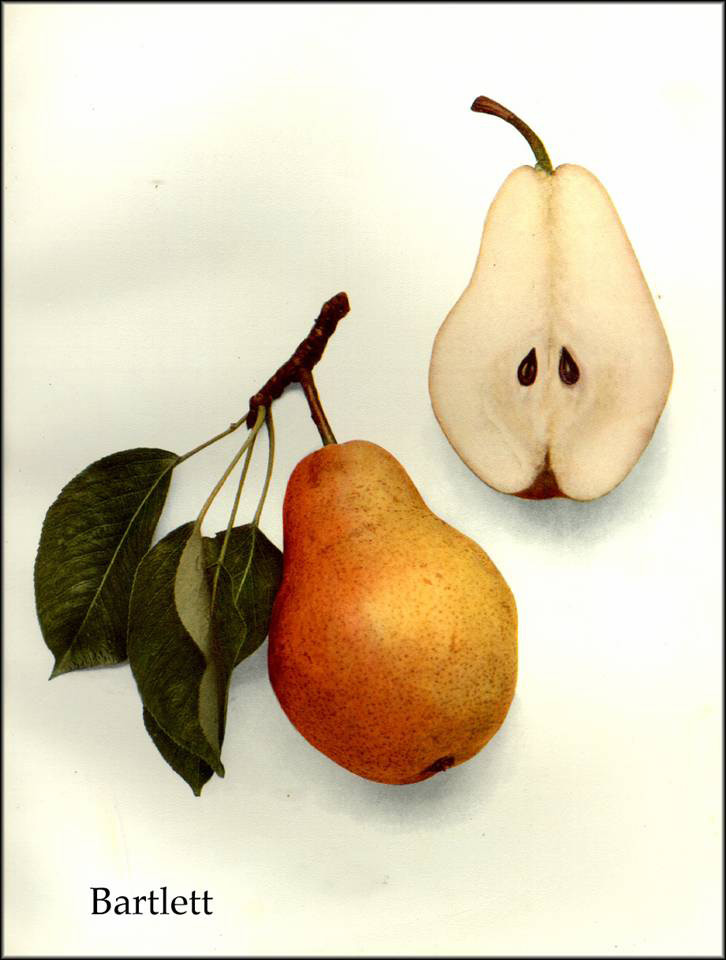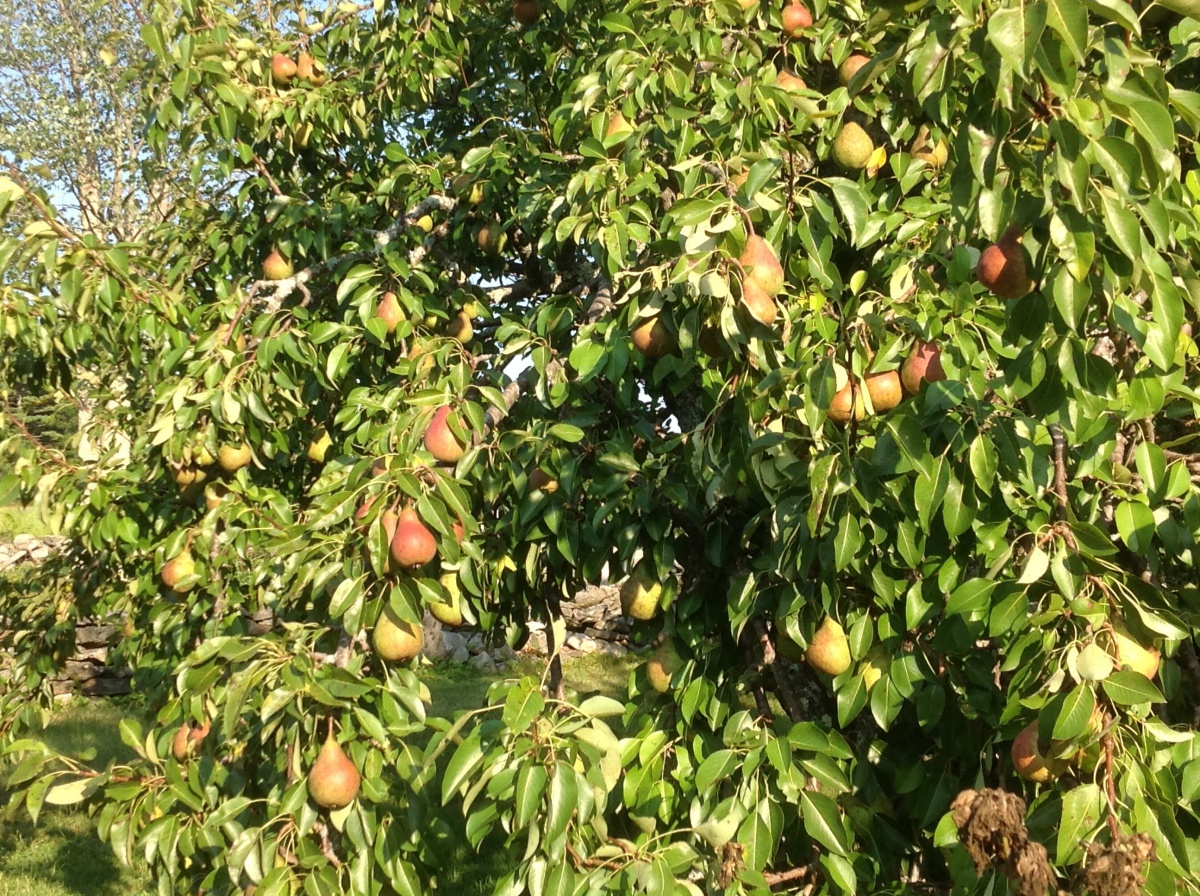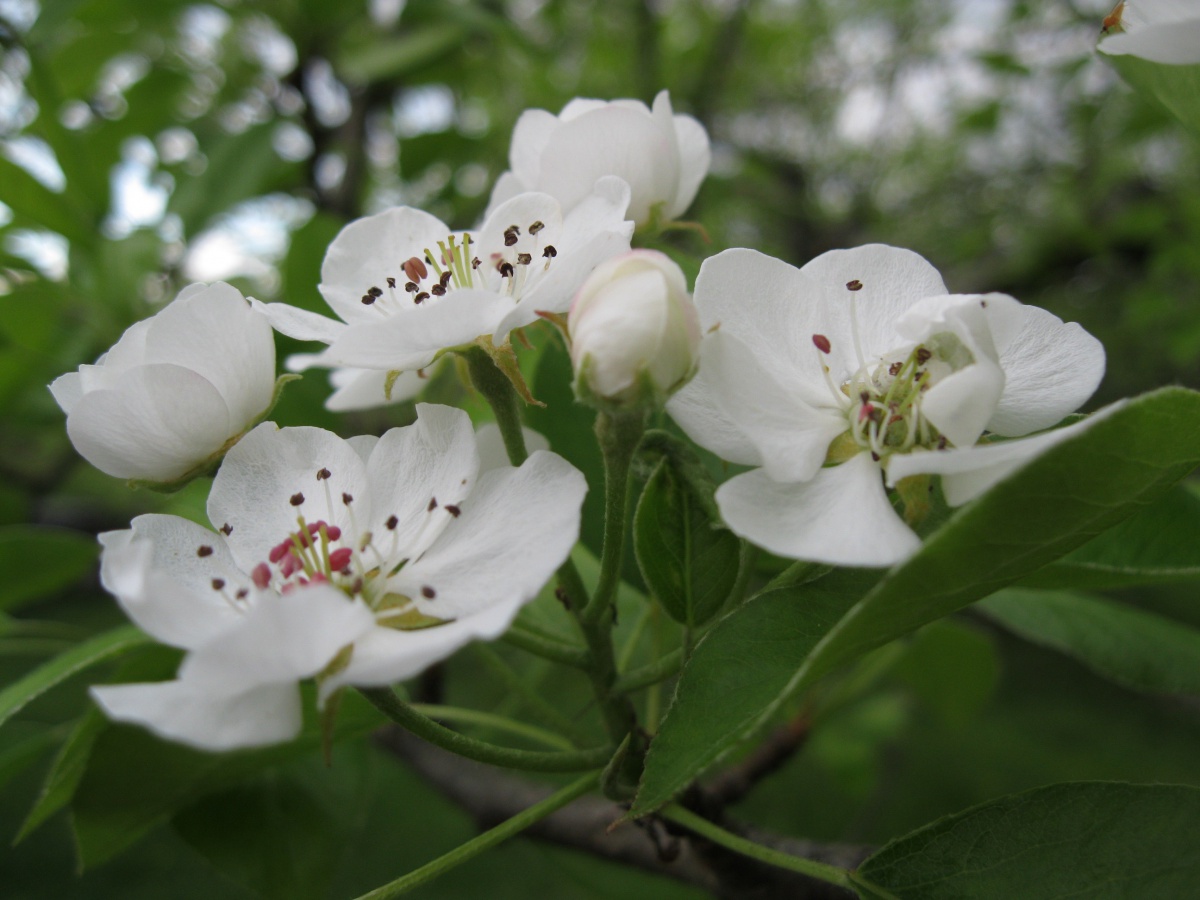Pears will grow well in all but the coldest areas of New Hampshire. Popular varieties such as Bartlett and Bosc are reasonably winter hardy where temperatures seldom fall below -25oF. However, pears bloom several days earlier than apples. As a result, late spring frost may damage developing buds, flowers, or fruit on frost-prone sites.
What about dwarf pear trees?
Pear trees, like other tree fruits, are produced by grafting the desired variety (such as Bartlett) onto a rootstock. Pear seedlings are commonly used as rootstocks and produce trees that are reasonably winter hardy and vigorous. Pear trees have upright growth habits, and trees grafted onto seedling rootstocks can be quite tall. They are normally spaced 15 to 20 feet apart in the home garden.
Dwarf pear trees are produced by grafting pear varieties onto selected dwarfing rootstocks. Traditionally, quince roots were used to create dwarf pear trees. The result is a tree approximately half the size of seedling-rootstock trees. Quince roots aren’t as winter hardy as pear seedling roots and don’t tolerate either excessive soil moisture or drought well. In addition, quince roots are very susceptible to fire blight, a bacterial disease. Dwarf pear trees are normally planted eight feet apart.
Newer semi-dwarfing rootstocks are available for pear. Pear varieties grafted onto these semi-dwarfing rootstocks should produce trees about 2/3 the size of standard trees. In addition, these semi-dwarf pear trees will produce fruit earlier in life. Examples of these semi-dwarf rootstocks are OHxF 40, OHxF 333, OHxF 513 and OHxF 87. Some fruit tree nurseries will give you the option of selecting both the variety and the rootstock on which it is grafted. These are equally good choices. Space semi-dwarf pear trees 12 feet apart in the home orchard.

Purchasing nursery stock
Purchase trees from a reputable garden dealer or nursery. Tree quality should be the major consideration when purchasing trees. Heavily branched, one-year-old trees usually grow better than smaller ones.
Did You Know?
Pear trees will do reasonably well in a wide range of soil types, although they will not tolerate poorly drained soils with a high water table. Pear trees require full sunlight all day long.
All pear varieties require cross-pollination to set good crops of fruit, although some varieties, such as Seckel, may set adequate crops when planted alone.
Varieties
Clapp’s Favorite is a late summer pear, ripening late August, with very large fruit with good flavor. Bartlett is the standard for flavor, and it ripens in early September in NH. Bosc is a good pollinator for Bartlett, and it ripens about October 1. Unfortunately, all three of these varieties are susceptible to fire blight. Seckel is a small, sweet, firm pear that may be partially self-fruitful and has good resistance to fire blight. Magness, Potomac and Moonglow offer excellent fire-blight resistance and fruit quality. Honeysweet and Luscious also offer good fire-blight resistance. For Coos County and other colder locations Flemish Beauty, Harrow Delight, Nova and Luscious are very cold-hardy choices.
Pollination requirements
All pear varieties require cross-pollination to set good crops of fruit, although some varieties, such as Seckel, may set adequate crops when planted alone. With good bee activity, most combinations of varieties are satisfactory for cross-pollination. One combination that doesn’t work is Seckel and Bartlett. Pear flowers are not as attractive to bees as many other flowers, so we recommend planting three or more varieties. Some varieties, such as Magness and Luscious, do not produce good pollen, and therefore won’t work well as a pollinizer for other varieties.
Getting ready to plant
Pear trees will do reasonably well in a wide range of soil types, although they will not tolerate poorly drained soils with a high water table. Pear trees require full sunlight all day long.
Proper soil preparation is an important first step. For best results, eradicate perennial weeds, such as quackgrass, before planting. The soil pH should be 6.0-7.0 for pears. Soil testing can be done through a number of private and public labs. UNH Cooperative Extension offers this service. Forms and instructions are available on our website or you can call your local county Extension office or our Info Line at 1-877-EXT-GROW (1-877-398-4769).
If the planting site isn’t ready when the trees arrive from the nursery, unwrap the trees and “heel-in” the roots in moist soil in a shady spot. Plant the trees before growth begins in the early spring; early to mid- May is ideal.

A tree of Clapp’s Favorite in a home orchard, loaded with fruit at harvest time. Photo: B. Sideman
Planting the tree
If the planting site is especially gravelly or sandy it might be useful to incorporate organic matter from green manure crops or surface-applied sources such as compost. The plant debris or surface-applied organic matter should be mixed thoroughly with soil before digging the plant- ing hole.
Dig a hole large enough to allow the roots to be spread out completely. This usually will require a hole that’s much wider than it is deep. Back- fill the planting hole using topsoil. Don’t use sod to fill the hole.
Plant dwarf and semi-dwarf pear trees so the graft unions are two or three inches above the soil surface. The graft union is the point where the variety was grafted onto the rootstock. Backfill the hole two-thirds full, soak in two gallons of water and finish backfilling. Don’t leave a depression or water catching basin around the tree. Remove any tags or labels attached to the trees, as they may girdle the trunks after growth begins.
Don’t add fertilizer to the planting hole. Trees may be fertilized after rain has thoroughly settled the soil around the roots (two to three weeks after planting) with one-quarter pound of 10-10-10 or an equivalent amount of compost by spreading it lightly in a wide circle 16 to 20 inches from the tree trunk.

Figure 3. Pear blossoms, ready for pollination. Photo: B. Sideman
Pruning at planting
Cut back one-year-old whips (unbranched trees) to 33 to 36 inches above the ground. Trees less than 36 inches tall don’t need heading back. If the trees you received from the nursery are well branched, leave as many well-positioned branches in the tree as possible to aid growth. Remove branches that are very upright (e.g. with crotch angles narrower than 60°) and those lower than 18 inches from the ground.
Training the young pear tree
Young pear trees should be trained to the central-leader system (Figs. 3 and 4) used in training apple trees. Because of their upright growth habit, young pear trees may appear too dense; however, once they begin to fruit, the branches will spread naturally. Limit pruning of young trees to those cuts necessary to maintain the dominance of the central leader. To promote fruiting at an earlier age, position lateral branches to achieve a branch angle or 60o to 75o from the trunk or leader. Properly positioned branches will grow and fruit well without competing with the trunk of the tree for dominance. Position branches by bending the branch to proper position and securing it with heavy twine tied to a stake driven into the ground or to an anchor. A gallon milk jug filled with wa- ter makes a good anchor. Insure that the twine does not girdle the branch.

Figure 4. Pear tree before pruning. Photo: W. Lord

Figure 5. Pear tree after pruning. Excess limbs, over-sized limbs and water sprouts were removed. Photo: W. Lord
Pruning the mature pear tree
Because of their susceptibility to fire blight, pear trees are pruned less severely than apple trees. Pruning is often limited to removing suckers and those branches that are excessively large compared to its neighbors. It may be necessary to do some thinning out of smaller branches to allow better light and spray penetration and to improve size and color of the fruit. The best course of action is almost always to remove a problem branch entirely. The optimum height of a mature standard pear tree is between 15 and 18 feet. This height can be maintained by cutting the central leader back to a weaker, up-right growing side branch every 2 or 3 years.
Fertilizing pear trees
Pear trees growing too vigorously are more susceptible to fire blight infection than those making moderate growth. Fertilize young pear trees with up to a pound of a general garden fertilizer such as 10-10-10 or its equivalent. Older trees that are growing well (more than 10 inches of new growth each year) need no fertilizer.
Managing pests and diseases
Fire blight is the most serious disease of pear and pear psylla is the main insect pest of pears. Basic informa- tion on how to manage these problems and others is available in the publication “Home Fruit Spray Schedule”. Additional information can be found by contacting our Info Line at 1-877-EXT-GROW (1-877-398-4769).
Harvesting and ripening
Pears differ from many other fruits in that they reach optimum harvest maturity while they are still firm and green. Some pear cultivars (including Clapp’s Favorite, Bartlett, and Bosc) are susceptible to a disorder called “core breakdown” or “internal breakdown” if they are allowed to ripen on the tree. With this disorder, the flesh around the core becomes brown and soft. Optimum harvest maturity can be hard to determine; the best approach is to 1) have an idea of the approximate maturity time for the cultivar, 2) watch for a slight color change from a darker to a lighter shade of green, and 3) monitor fruit size (except Seckel, pears should be at least 2 inches in diameter at the base when mature). The best quality will be achieved if pears are harvested slightly before they are ripe, stored at 30-32F (refrigerator temperature works well in a home setting), and then ripened at room temperature (60-70F) for up to a week before eating or canning. Pears are very delicate, and should be handled very carefully during harvest and storage to prevent bruising or wounds.
About the Author: Dr. Becky Sideman is an Extension Professor in the Dept. of Biological Sciences at UNH, and is the state specialist for Sustainable Horticulture for UNH Cooperative Extension. Her program emphasizes vegetable and berry crop production including season extension for Northern New England.w Hampshire.
For More Information
State Office
Taylor Hall
59 College Rd.
Durham, NH 03824
http://extension.unh.edu
Education Center and Information Line
answers@unh.edu
1-877-EXT-GROW
(1-877-398-4769)
9 am-2 pm M-F
Search key words:
"UNH Education Center"
Download the resource for the complete fact sheet.
